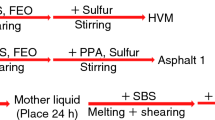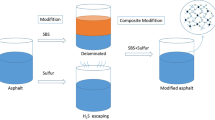Abstract
Crosslinker and plasticizer were used to prepare Styrene-butadiene-styrene (SBS) compound-modified asphalt. The physical and rheological properties of modified asphalt were tested, and the morphology observation and thermal analysis were used to study the structural characteristics of modified asphalt further. The physical tests showed that plasticizer (dioctyl phthalate) improved the low-temperature properties of SBS-modified (SM) asphalt and crosslinker (sulphur) improved the stability and elastic recovery of SBS/plasticizer-modified (SPM) asphalt. The SBS/plasticizer/crosslinker-modified (SPCM) asphalt owns better physical properties before and after ageing. The rheological properties were studied by using creep tests. Creep tests indicated that plasticizer declined the deformation resistance of SM asphalt and crosslinker increased the recoverable deformation of SPM asphalt. Morphology observation showed that crosslinker improved the compatibility between SBS and asphalt greatly and ageing prompted the degradation of SBS to a great extent. Thermal analysis showed the effect of plasticizer and crosslinker on the thermal behaviour of SM asphalt, and the calculation for E a and endothermic peak area showed the structural characteristics of modified asphalt before and after ageing.









Similar content being viewed by others
References
Wen GA, Zhang Y, Zhang YX, Sun K, Fan YZ. Rheological characterization of storage-stable SBS-modified asphalts. Polym Test. 2002;21:295–302.
Lu X, Isacsson U. Rheological characterization of styrene–butadiene–styrene copolymer modified bitumens. Constr Build Mater. 1997;11:23–32.
Shuler TS, Collins TH, Kirkpatrick JP. Polymer-modified asphalt properties related to asphalt concrete performance. In: Briscoe OE, editor. Asphalt: relationship to mixture. Philadelphia: American Society for Testing and Materials; 1987. p. 179–82.
Zhu JQ, Birgisson B, Kringos NK. Polymer modification of bitumen: advances and challenges. Eur Polym J. 2014;54:18–38.
Sheng JA, Li FP, Chen J. Technical specifications for construction of highway asphalt Pavement. Beijing: Ministry of Communications of the People’s Republic of China; 2005.
Mothé MG, Leite LFM, Mothé CG. Thermal characterization of asphalt mixtures by TG/DTG, DTA and FTIR. J Therm Anal Calorim. 2008;93:105–9.
Zhang F, Hu CB. Influence of aging on thermal behavior and characterization of SBR compound-modified asphalt. J Therm Anal Calorim. 2014;115:1211–8.
Zhang F, Yu JY, Han J. Effects of thermal oxidative ageing on dynamic viscosity, TG/DTG, DTA and FTIR of SBS- and SBS/sulfur-modified asphalts. Constr Build Mater. 2011;25:129–37.
Zhang F, Hu CB. The research for SBS and SBR compound modified asphalts with polyphosphoric acid and sulfur. Constr Build Mater. 2013;43:461–8.
Zhang F, Yu JY, Wu SP. Effect of ageing on rheological properties of storage-stable SBS/sulfur-modified asphalts. J Hazard Mater. 2010;182:507–17.
Zora V, Chaminda W, Jiri S, Ludo Z. Creep characteristics of asphalt modified by radial styrene–butadiene–styrene copolymer. Constr Build Mater. 2007;21:567–77.
Hu RY, Bahia HU, Zhai Z, Zheng M. Measuring resistance of asphalt binders to permanent deformation using DSR device. In: TRB 80th annual meeting. Washington, DC; 2001.
Pang L. Research on the ultraviolet radiation ageing characteristics of asphalt (Dissertation). Wuhan City: Wuhan University of Technology; 2008.
Han J. Research on preparation and performance of ultraviolet light aging resistant bitumen (Dissertation). Wuhan City: Wuhan University of Technology; 2011.
Zhang XN. Asphalt and asphalt mixture of sticky elastic. 1st ed. Beijing: Science Press; 2006.
Chen JH, Li CR. Thermal analysis and application. 3rd ed. Beijing: Science Press; 1985.
Juan M, Jiménez M, Luis CQ, Carmen R. Characterization of petroleum bitumens and their fractions by thermogravimetric analysis and differential scanning calorimetry. Fuel. 1996;75:1691–700.
Radhakrishnan CK, Sujith A, Unnikrishnan G. Thermal behaviour of styrene–butadiene rubber/poly(ethylene-co-vinylacetate) blends TG and DSC analysis. J Therm Anal Calorim. 2007;90:191–9.
Gao JL. Analysis and evaluation of bitumen new index and additive index (Dissertation). Nanjing City: Southeast University; 2005.
Gao JL, Huang XM, Li HJ. Evaluation method of differential scanning calorimetry for asphalt performance. J Traffic Transp Eng. 2005;5:37–42.
Author information
Authors and Affiliations
Corresponding author
Rights and permissions
About this article
Cite this article
Zhang, F., Hu, C. The research for thermal behaviour, creep properties and morphology of SBS-modified asphalt. J Therm Anal Calorim 121, 651–661 (2015). https://doi.org/10.1007/s10973-015-4595-z
Received:
Accepted:
Published:
Issue Date:
DOI: https://doi.org/10.1007/s10973-015-4595-z




